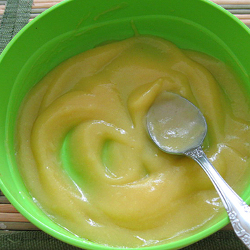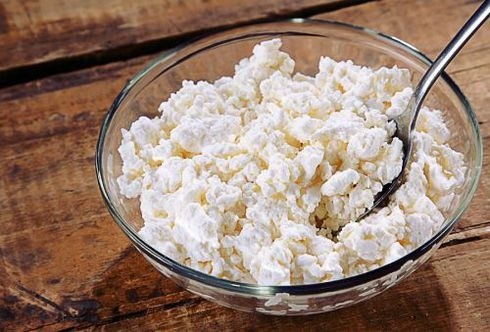The ideal food for an infant is mother's milk, and in case of its absence, highly adapted nutritional formulas. This nutrition for a child who is breastfed is quite enough up to six months of age, and for an artificial child only up to 4 months. Next, we will describe in detail what should be sample menu a child at 4 months old, who is on.
Feeding a 4 month old breastfed baby
At the 4th month of life, the child's activity increases: he sleeps less, motor skills are rapidly developing (the child is already turning over on his side, taking toys). This means that the time has come when it is time to accustom the baby to ordinary products. First meal in meal 4 month old baby on the artificial feeding is vegetable puree. Complementary foods should be introduced in the morning to observe how the child will behave after tasting a new dish.
It should be said that you need to cook vegetable puree without salt, spices and oil. To prepare this, you should take vegetables that do not cause allergies (not bright) and do not cause increased gas formation in the intestines (do not use legumes). And when the baby's body adapts to the intake of such food, then it can be slightly salted and a couple of drops of oil added.
You should not immediately replace the whole feeding with vegetable puree, it is enough to give 1-2 spoons on the first day, and then feed the baby with the mixture. If the child tolerates the new food well, then the next day you can give 4 spoons. Each new dish must be introduced within 2 weeks.
How to feed a baby at 4 months on artificial feeding?
And how to feed a child at 4 months on artificial feeding, when vegetable puree has already been introduced into the diet?
The second dish is milk porridge, which you can cook yourself or buy a dry mix in the store, which you just need to pour hot water. Now vegetable puree should be moved to the third meal, and milk porridge should be introduced during the second meal. The principle of introducing milk porridge into the diet is the same as that of vegetable puree.
Thus, by the 5th month of life in a child who is bottle-fed, 2 meals have been replaced with regular foods. Baby food should be given from a spoon, not from a bottle. If at the time of the introduction of complementary foods the child is not healthy, then you should not give him new products, it is better to wait until the baby recovers. And most importantly, in no case should a child be forced to eat, food should be praised and recommended to the baby to try a new tasty dish.
Should be monotonous, but useful. The fact is that at this age the baby’s stomach cannot yet process large volumes of heavy carbohydrates, but it copes with lactose without difficulty. Nevertheless, it is already worth thinking about expanding the baby's diet.
at 4 months
First you need to determine and draw up a general daily routine. At 6.30 am the first time is recommended (early breakfast). Up to 8.00 the baby should be awake. Then for 2 hours the child needs to sleep. Morning sleep is the strongest and most useful after night sleep.
At 10:30 it's time for the second feeding. Then an hour and a half of wakefulness, which can end with a light massage. daytime sleep starts at 12.30. At this time, it is recommended to take a walk so that the baby can sleep in the fresh air. It is very useful for the respiratory system and brain activity of the child. The third feeding should take place closer to 14.30. Then again a period of wakefulness and sleep. A child can have dinner at 18.00 or at 18.30 (at the request of the baby). During the evening wakefulness, it is recommended to bathe the baby and do gymnastic exercises to strengthen the muscular system. The last feeding begins closer to 22.30. After it, the baby should be laid on night sleep.
It is important at this stage to build just such a diet for a 4-month-old baby. The intervals between feedings should be from 3.5 to 4 hours.
Diet at 4 months
From 17-18 weeks of life, the baby should gradually move on to 5 meals a day. At the same time, a 4-month-old baby needs to be expanded, replenishing it with new vitamin products. A baby should eat 1/6 of its weight per day. One serving is approximately 180 g.  The first food that is allowed to supplement a 4-month-old baby's diet is broccoli. This vegetable is rich in vitamins and minerals necessary to strengthen the immune system. Essentially, on initial stage expanding the baby's diet are allowed almost all vegetables, except for potatoes, carrots and beets.
The first food that is allowed to supplement a 4-month-old baby's diet is broccoli. This vegetable is rich in vitamins and minerals necessary to strengthen the immune system. Essentially, on initial stage expanding the baby's diet are allowed almost all vegetables, except for potatoes, carrots and beets.
Breastfed babies are more tolerant of the introduction of new foods. Therefore, by the end of the 4th month, they are allowed to give a spoonful of apple juice. At this age, mother's milk (mixture) should remain the main one. All other products are additional.
Proper complementary foods
The nutrition of a 4-month-old baby should be rich not only in carbohydrates and proteins, but also in vegetable fats. At this age, babies lay the foundation for a healthy body. That is why it is so important to gradually introduce new foods into the diet from 4 months.
Any juices at this age are not recommended, since in most cases they entail an allergic reaction and severe colic. A similar supply of vitamins and microcomponents is found in various vegetables and fruits.  Complementary foods must be in semi-liquid form. Puree is made from boiled (steamed) products in a blender. Bananas can be grated on a fine grater. Complementary foods are recommended to be given a few minutes before the main feeding in a small amount (1-2 teaspoons). The transition from one new product to another is done only after 7-10 days, so that the stomach has enough time to get used to it.
Complementary foods must be in semi-liquid form. Puree is made from boiled (steamed) products in a blender. Bananas can be grated on a fine grater. Complementary foods are recommended to be given a few minutes before the main feeding in a small amount (1-2 teaspoons). The transition from one new product to another is done only after 7-10 days, so that the stomach has enough time to get used to it.
Meat or fish should not yet be introduced into the diet of a 4-month-old baby. If the baby has a skin rash on the face or body, New Product should be removed from the diet immediately. Also, an allergic reaction can manifest itself in the form of constipation, diarrhea, gneiss, flatulence.
Complementary foods
To start with, the nutrition of a 4-month-old baby can be consistently enriched with broccoli, cauliflower and zucchini. Each vegetable is introduced separately for 1-2 weeks. If there is no allergic reaction from the puree, you can expand the diet to cereals. By consistency, they should be liquid so that the child eats them through the nipple.  At this age, buckwheat and oatmeal are best suited. Some experts also advise rice, but because of it, babies often have indigestion and constipation. The introduction of porridge is also carried out gradually, starting from 30 g.
At this age, buckwheat and oatmeal are best suited. Some experts also advise rice, but because of it, babies often have indigestion and constipation. The introduction of porridge is also carried out gradually, starting from 30 g.
Should not replace full feeding yet. It is allowed to give new products 1-2 times a day before the main meal in a proportion of 50 to 50.
By the end of the month, you can add pumpkin and banana puree to your diet. From fruits, only the most non-allergenic, such as a pear, an apple, should be selected. It is important that the puree be made from boiled products, and not from fresh, grated ones.
Approximate daily menu
The first and last feeding must be breastfeeding. At 10.00, vegetable puree with a drop of olive oil is allowed as complementary foods. After 10-15 minutes, you need to start the main meal. Before lunch or evening breastfeeding, an infant can be given 2 teaspoons of semi-liquid baby cottage cheese.  The nutrition of a 4-month-old artificial child is allowed to diversify with special kefir, that is, a sour-milk mixture. It is best to start a new day (first breakfast). It is worth noting that the main food product is the mixture. As a morning meal closer to 10.00, you can alternate buckwheat porridge and vegetable puree. In the evening, it is allowed to give the child 2 teaspoons of baby cottage cheese or a banana.
The nutrition of a 4-month-old artificial child is allowed to diversify with special kefir, that is, a sour-milk mixture. It is best to start a new day (first breakfast). It is worth noting that the main food product is the mixture. As a morning meal closer to 10.00, you can alternate buckwheat porridge and vegetable puree. In the evening, it is allowed to give the child 2 teaspoons of baby cottage cheese or a banana.
The intervals between feedings should be up to 4 hours, with the exception of nighttime (about 8 hours). It is important to adhere to the established diet so that the baby's stomach adapts faster. At breastfeeding portions should be slightly smaller than with artificial. Compotes and soups in such early age prohibited. Complementary foods in the form of vegetable and fruit purees should be taken from a spoon, cereals - from a bottle.
From birth, the diet of babies is not very diverse - newborns are fed with breast milk or an adapted milk formula, or the second is used as supplementary feeding for infants, if necessary. The menu of a child at 4 months does not differ in an abundance of dishes, and usually babies eat everything the same as before. But many parents decide to replenish the child's diet with new products at this particular age. Yes, and grandmothers insist on the introduction of natural juices, starting from another 2 months. But the World Health Organization (WHO) recommends not starting complementary foods until the child is six months old.

By some signs, you can determine whether the child is ready for complementary foods or not.
There are several key points that make it clear to the mother that the child is ready for the introduction of supplementary food:
- No gag reflex when spoon fed. In children under 4 - 6 months of age, an increased gag reflex, i.e., an attack of vomiting appears when a solid object enters the middle of the tongue. Until this reflex fades, the introduction of new products is pointless.
- food interest. A four-month-old baby is unlikely to have such an interest, but there are rare exceptions. Food interest means that when a child sees how his parents eat, he reaches for food, makes chewing movements or opens his mouth.
- Underweight. Simply put, the child does not eat the same amount. breast milk or mixtures. As a rule, the baby will be restless, often waking up at night, not gaining weight.
- Tendency to constipation, iron deficiency in the blood (anemia). In order not to torment the baby with medicines, gas pipes and candles, new food products are introduced that will help overcome these problems.
However, if parents want to replenish the child’s diet with new products so early, and the baby has stopped eating breast milk, you need to consult a pediatrician. The doctor will help you choose a formula that can be used to supplement the child. And then full-fledged complementary foods can be started within the 6 months recommended by WHO.
Regardless of whether the child is artificially or breastfed, if there are no special reasons for the early replenishment of the diet with “adult” food, the baby is gaining weight well, developing according to age, then you should not rush to get acquainted with new products.
Where to begin?
Opinions of pediatricians on this topic often differ - some argue that you should start with cereals, others are sure that you must definitely start with fruits, and still others say that vegetables are ideal for introducing a baby to “adult” food. And absolutely all these judgments are true, besides, they can be easily explained. After all, pediatricians recommend a certain type of first food for an individual child, based on the problems that early introduction of new products should solve.
If the child is on an artificial type of feeding, while having problems with being overweight, then it will even be useful to introduce complementary foods at 4 months. It is better to start with vegetables, as they are lower in calories and do not affect weight gain.
If the artificial person has no problems with weight, you can start feeding either with vegetables or cereals, at the discretion of the parents. When a child has a pronounced weight deficit, the baby often wakes up at night from hunger, then you should start with cereals.
The same principles of introducing new foods apply to children who are breastfed. If up to 4 months the baby received a mixture as a supplement, upon reaching this age, you can replace it with porridge. The main thing to remember is that you still cannot stop breastfeeding your baby.
Start complementary foods with fruits only if you are prone to constipation. Prunes help especially well, which can be included in the child's menu at this age. In other cases, the introduction of fruits in the first place can play a cruel joke on parents - sometimes the child does not want to eat unleavened vegetables after them.
What foods can be given?

Homemade zucchini puree for baby's first feeding
Not all vegetables, fruits and cereals can be used in a baby's diet. The list of such vegetables is small:
- vegetable marrow;
- cauliflower;
- broccoli.
These vegetables are less allergenic and easier to digest than the rest. As for cereals, gluten-free dairy-free cereals are used for the first complementary foods:
- buckwheat;
- rice;
- corn.
The nutrition of a 4-month-old baby can be varied with fruits - the first is usually given a try applesauce, then you can already introduce prunes, pears or peaches.
Replenishing the diet: what to give and how much?
If you do not know the main rules for introducing new foods into the diet of a four-month-old baby, you can provoke the appearance of allergies, colic, or stool disorders. First of all, it should be remembered that at 4 months a baby should not eat meat, fish, exotic and citrus fruits, red vegetables, sweets and chocolate. True, this does not mean that other products can be given to the baby in unlimited quantities.
- If the replenishment of the diet begins with mashed potatoes, whether fruit or vegetable, the main thing to remember is that they should consist of one component.
- It is better to choose cereals that are dairy-free and do not include any additives.
- Multi-component purees and cereals are introduced into the baby's diet after 6 months.
- The first feeding should be in a semi-liquid form and offered to the baby from a spoon.
Of particular importance is the timing of the introduction of a new product. It is best to try something new at lunchtime before the main meal, i.e. before breastfeeding or formula. And on the first day it is correct to offer the baby no more than 1 teaspoon. With each subsequent day, the portion increases by 2 times until the amount of food that the baby eats reaches 100-120 grams and replaces one full feeding. Only after one product has been fully introduced can the next product be introduced, and such a scheme is suitable for each product. So the menu of a child at 4 months will become more diverse every week.
Which is better: buy or cook?

Baby apple puree FRUTONYANYA for feeding a child from 4 months
You can cook mashed potatoes or porridge yourself, or you can buy it in a specialized department. If parents decide to prepare food for the child, it is better to use vegetables and fruits grown on their own. Purchased, especially purchased in the cold season, are probably “stuffed” with chemicals. The same applies to store-bought frozen vegetables and vegetable mixes.
Children's food should not be greasy, not spicy, not salty and not sweet. Frying and baking dishes for children is also prohibited. When preparing mashed potatoes for a four-month-old baby, you can not use vegetable and especially butter. This can be done in a couple of months, when the baby's body gets used to the "other" food.
All vegetables and fruit purees prepared according to one recipe:
- 100 g raw vegetables;
- 2 tbsp. l. water, breast milk or formula.
A vegetable or fruit is cooked until cooked, it’s not even scary to overcook (so it will be easier to grind). You can also cook for a couple, here it is already more convenient for parents. After that, add liquid to the vegetable or fruit and chop with a blender (or mash with a fork) until a homogeneous mushy state.
It is impossible to salt, pepper and add sugar to dishes for four-month-old babies. Taste buds in a child are not yet the same as in adults. Neglecting this rule, parents themselves instill the wrong eating habits in the baby.
Diet
The nutrition of infants and artificials, as a rule, is very different. The World Health Organization (WHO) recommends that infants be exclusively breastfed for up to 4 months and only when the baby so desires. Although 20 years ago, women in maternity hospitals were taught that feeding should be carried out according to the regimen, there is a break of 3 hours between feedings. And artificial people eat at about 3.5-4 hour intervals.
An approximate scheme of the diet, wakefulness and sleep of a baby at 4 months:
| 6.00 | first or early breakfast; |
| 6.30-8.00 | wakeful period |
| 8.00-10.00 | dream |
| 10.00 | lunch |
| 10.30-12.00 | wakeful period |
| 12.00-14.00 | sleep (ideally outdoors) |
| 14.00 | dinner |
| 14.30-16.00 | wakeful period |
| 16.00-18.00 | dream |
| 18.00 | dinner |
| 18.30-21.00 | wakeful period |
| 21.00-22.30 | first night dream |
| 22.30 | second dinner |
| 23.00-6.00 | night sleep |
So it turns out that the artificial person eats 5 times a day, and a child who is breastfed can be breastfed up to 10 times. One feeding should be enough for the child for 3-4 hours. But do not forget that the breast for the baby is not only food, but also a way to communicate with mom and calm down, the main assistant in falling asleep. Therefore, breastfed babies do not always maintain the required interval between feedings.
sample menu
How to feed a baby at 4 months is a simple question, because the baby's menu does not change much. At this age, he is just beginning to get acquainted with adult food. There are many tables on the network in which it is written detailed plan child nutrition. But their essence is the same - the introduction of a new product falls at lunch time. The rest of the meals remain unchanged.
The only thing that can still change is how long the next feeding will be after a full portion of complementary foods. After all, a full-fledged portion of "adult" food helps to saturate the body for a longer period of time than 3 - 3.5 hours.
Some sources report that the baby's diet needs to be replenished with vegetable and fruit juices, but these are nothing more than relics of the past. Previously, 20 years ago, pediatricians believed that the vitamins that the baby receives from mother's milk are not enough for normal growth and development.
Over time, studies have shown that a baby can be exclusively breastfed for more than 6 months without experiencing nutritional deficiencies. Juices have a completely detrimental effect on the baby's stomach, so they are introduced into the diet no earlier than 6 months, and WHO does not recommend up to 1 year.
Summary
When introducing the first complementary foods, it is important not to overdo it - if the child is not ready for new food, then you should not torment him. You can try to offer him a new product in a week, but it is not a fact that he will not refuse unusual food again. And if an allergic reaction appears after a new product, you need to stop feeding for 7-10 days and only then try again, and from another product. Not all four-month-old babies are happy to accept the initiative of their parents to introduce new dishes into their diet, and parents should always remember this.
The diet of a child at 4 months depends on the type of feeding and individual characteristics. little man. Choosing the right feeding regimen, every mother seeks to find the best option that would meet the needs of a growing organism. During infancy, a prudent approach is needed to the introduction of new foods, changing the diet, due to possible negative reactions of the body to unfamiliar dishes.

If the baby is fed only breast milk in sufficient quantities, then changes in the diet will be negligible. This is due to the fact that immature digestive system not yet ready to accept food other than breast milk. At normal development baby and sufficient weight gain, there is no need to introduce complementary foods. By 4 months, the number of attachments to the breast decreases, but the amount of milk consumed per feeding increases.
Advocates of hourly feeding are reducing the number of latches from 6 to 5. Now the waiting period new opportunity to satisfy hunger increases from 3 hours to 3.5 - 4. For some children, pediatricians still recommend the introduction of complementary foods at this age. The reasons for this decision are the presence of underweight in the child, low hemoglobin, as well as other examination results.
Where to begin?

Before listing the main products that are suitable for the first complementary foods, it is worth making a reservation right away: any of them should be introduced in microdoses. Fruit juices are introduced drop by drop (from 2-3 drops at first) with a gradual increase in their amount. A particularly valuable product is vegetable dishes (mashed potatoes or soup). They are able to solve the following tasks in the body of a small child:
- make up for the lack of minerals and vitamins;
- normalize bowel function due to the fiber content;
- maintain a healthy taste and prevent rejection of breastfeeding and other foods due to lack of sweetness.
Egg yolk is an important food product. They begin to gradually add it to vegetable puree, which is thereby enriched with easily digestible valuable protein and vitamins.
Cooking and living according to the schedule
The most rational is the following feeding regimen for a 4-month-old baby who is breastfed:
Vegetable puree should be introduced in small portions before breastfeeding. When introducing a child to a new type of food, it is very important to patiently and constantly introduce an unfamiliar product into his diet. Pediatricians advise at first introducing one-component vegetable purees without oil and egg yolk. After it becomes clear that the child has tolerated the appearance of a new product in his diet, you can begin to add oil drop by drop to the puree, introduce the yolk and other vegetables.
Within a month, you can increase the portion of vegetable puree to 150 grams.
Cottage cheese is an important source of protein and calcium

There is controversy over the advisability of introducing cottage cheese before eight months of age. Some doctors claim that this creates an excessive load on the excretory system, especially the kidneys. Others, on the contrary, argue that cottage cheese is good for children of this age. It is better to resolve such a question with a pediatrician who can help a young mother decide in this situation.
Feeding a formula-fed baby
The diet of a child at 4 months who receives breast milk substitutes has its own characteristics. Firstly, in addition to vegetable puree, its menu contains liquid cereals. At this age, porridge is introduced into the diet as a second complementary food. Vegetable puree is introduced a little earlier - in the fourth month of life. The break between the introduction of the first and second complementary foods should be at least three weeks. The best cereals for complementary foods are gluten-free. These cereals include rice, corn and buckwheat, respectively, buckwheat rice and corn porridge should appear in the baby's menu first.
Let's give an approximate diet of a child at the age of 4 months on artificial feeding.
The main thing is not to harm
When introducing new dishes into the diet, you should not chase after the prescribed deadlines and try to squeeze the child into a rigid framework. The main thing is the peace and health of the baby. There are times when acquaintance with a food product will have to be postponed. This is justified when the child is unwell, before immunization (administration of vaccines), in case of indigestion or teething. Sensitive attention and care will tell a young mother how best to build a routine baby food taking into account the individual characteristics of your child.
This will accustom the baby's stomach and intestines to coarser food, teach his body to extract nutrients from natural food, and make up for the deficiency of useful substances necessary for the body. No matter how manufacturers of adapted mixtures praise their products, the mixture is still not mother's milk.
When can we start feeding?
If the child does not know how to sit on his own, cannot grab objects with his hands and pushes out a spoon with his tongue, spilling water on his chin, it is too early to introduce new food for him. How can a mother know that it is already possible to give complementary foods to a baby at 4 months on artificial feeding? For this you can use the following signs readiness of the child: the baby knows how to sit, hold objects with handles, the weight of the child has doubled since birth, there is no ejection reflex of the tongue, the baby lacks 1 liter of the adapted mixture per day.
It is good if the baby can already express his attitude to food: he will deviate if he does not like it. It is very important to feed the baby from a spoon, and not to prepare liquid foods for him and feed him from the nipple. Because food must be thoroughly broken down by saliva and enter the stomach ready for further digestion. A good reason to start introducing "adult" food into your child's diet is his interest in foods on his mother's plate. If your baby is trying to nibble on a carrot or chew on an apple, it's time to start solid foods.
In the interval between 4 and 5 months of a child’s life, his digestive system improves, the stomach secretes digestive juices, the production of enzymes is activated, the main purpose of which is to break down food, the intestinal walls stop passing large molecules and a chewing reflex appears. But all these changes, as well as interest in adult food, are individual, more precisely, the period of their appearance differs in different children. One child is ready for, and for the other too early and at 5 months. Therefore, it is necessary to solve the issues of complementary foods on an individual basis, after consulting with a pediatrician.
How to start supplementary feeding of a child at 4 months?
If old-school pediatricians unanimously claim that the best food for such a small child is freshly squeezed fruit juice, it is rich in vitamins and trace elements, it has an interesting taste that trains the taste buds of the baby. It will not be difficult for him to move from sweet milk to sweetish juices. Then modern medicine considers three possible options: firstly, vegetable juice and vegetables in boiled and chopped form, secondly, cereals, and thirdly, fruit juice.
If the child is healthy, normally gaining weight, modern pediatricians advise vegetable juice or liquid vegetable puree. A good start in complementary foods would be zucchini or cauliflower. A little later, you can add potatoes, pumpkin and carrots.
If the baby is weak and underweight or has an unstable stool, the scales tilt in favor of cereals. Pediatricians recommend introducing fruit juices into more late dates due to their allergenicity. The number of allergy sufferers is growing every year, there is no need to rush with fruits and introduce your child into the clan of allergy sufferers.

To make vegetables lose less nutrients, they are recommended to be cut into large pieces and dipped in water brought to a boil. After the vegetables are cooked, they are allowed to cool and a homogeneous mass is prepared from them, grinding together with the broth. Puree is liquid.
The first portion of complementary foods should be very small, no more than 1 teaspoon without a slide.
The child should be allowed to get used to the new food, gradually increasing the portion gradually. At 4.5 months, you need to follow a few rules:
- puree must be prepared from one type of vegetable;
- if possible, it is better to buy homemade vegetables;
- if puree is purchased ready-made, you need to take those jars that indicate “from 4 months”;
- no need to add salt or sugar to the vegetable puree;
- the interval before introducing a new dish into the infant's diet should be a week, if the child's intestines do not respond very well, then 2 weeks;
- you can’t start complementary foods or introduce another “novelty” when the child is unwell;
- adding another product is not worth it on the day of vaccination and 3 more days after it;
- you need to give a new dish to the baby before feeding him with a mixture;
- increasing the amount of complementary foods, you need to reduce the amount of mixture for feeding, this will save the baby from overeating;
- after 2-3 weeks, one feeding of the child can be replaced with a completely “adult” meal in the amount of 150 grams;
- for feeding a child of 4 months old, 3-4 types of vegetables are enough.
If the baby is not gaining weight well, and the doctor advised to start complementary foods with porridge, you need to opt for those that do not contain gluten. You can start with buckwheat and rice porridge. Preference should be given to buckwheat, since rice is an excellent natural sorbent and it removes not only unnecessary substances from the body, but also useful minerals. It can be given 1-2 times a week. A little later it will be possible to connect corn and oatmeal. The principles for introducing cereals are the same as for vegetables, they start complementary foods with a teaspoon, increasing the amount of cereal every day.
Porridges that you can offer to your child are either ordinary cereals that need to be ground in a coffee grinder and boiled, special cereals for feeding children of the first year of life, which are dissolved in warm water (they do not need to be brewed) and ready-made cereals with vegetables in jars.
Common Mistakes
Inexperienced mothers, if the child, after the first or second attempt, refused to eat vegetables, quickly switch to fruits or cereals. This is not worth doing. You need to offer the child the same product several times. And only if he refused this food 7-10 times, you can move on to another vegetable dish. If you do not teach your child to eat vegetables, he may refuse this food altogether, preferring sweet cereals and fruit purees.

If mom is preparing a regular porridge, it needs to be brought to a homogeneous state, you can dilute it a little with an adapted mixture. You should not additionally sweeten cereals if special children's dry cereals are used. In general, you should not accustom a child to sweets. While the child is just getting used to new tastes, it is possible to form his taste habits and food preferences. Once a child gets used to eating a certain way, it will be difficult to change his eating habits. If a child likes sweets, he will prefer sweet confectionery, and this is a direct path to metabolic disorders.
Very often, mothers are in a hurry to introduce new foods into the diet of their child or give the child mixed vegetable salads. This should not be done for two reasons. Firstly, it is easier for the baby's intestines to digest a mono-dish. Secondly, if an allergic reaction develops, the allergen product can be easily removed.
How do you know that the introduction of the dish was successful?
At the age of 4 months, the child is not able to describe his condition, complain that the product does not suit him. Therefore, many mothers worry that they will not be able to recognize if the first complementary foods are not entirely successful. The criteria for the fact that everything went smoothly can be the general condition of the baby:
- he is active, cheerful and cheerful;
- the child's sleep is calm, he does not cry and does not wake up;
- the baby's skin is clean, there are no rashes;
- the child's stool retains its usual consistency and color;
- during defecation, the child does not cry, the tummy is soft, there is no flatulence.
If the child's condition does not correspond to the specified list in at least one of the items, then it is better to postpone acquaintance with new food. If rashes appear, the child becomes lethargic and irritable, or the quality of the stool has changed, then it is better to consult a pediatrician for advice and develop a menu with him.
